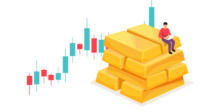Gold Trading for Dummies: A Beginner’s Guide
In the world of investment and finance, gold has always held a special place. It’s often considered a safe haven for investors, a hedge against economic uncertainties, and a valuable asset that can be traded for profit. But for beginners, the world of gold trading can be perplexing and daunting. This article serves as your comprehensive guide to understanding the basics of gold trading, from what it is to how to get started.
Gold, with its timeless allure and enduring value, has been a sought-after commodity for centuries. It’s not just the sheen of the precious metal that attracts us; it’s the promise of financial security, wealth preservation, and profit potential that makes gold a significant asset in the world of trading and investment.
Why Gold?
The Allure of Gold
Gold has a unique place in human history, often associated with wealth, power, and beauty. It’s been used for currency, jewelry, and art for centuries. This intrinsic value contributes to its appeal as an investment.
Gold as an Investment
Investors turn to gold as a hedge against inflation, economic uncertainty, and currency devaluation. In times of crisis, gold tends to retain its value or even increase, making it a popular choice for risk-averse investors.
Types of Gold Investments
Before diving into gold trading, it’s crucial to understand the different ways you can invest in gold.
Physical Gold
Physical gold investments involve buying actual gold in the form of coins, bars, or jewelry. These assets are tangible, and their value is tied directly to the gold’s weight and purity.
Paper Gold
Paper gold investments include gold exchange-traded funds (ETFs), gold futures, and gold mining stocks. These options allow you to invest in gold without the need to hold physical gold.
Market Dynamics
To become a successful gold trader, you must grasp the dynamics that drive the gold market.
Supply and Demand
Gold’s price is heavily influenced by supply and demand. Mining production, central bank reserves, and jewelry consumption all play a role in determining the availability of gold.
Factors Influencing Gold Prices
Numerous factors can impact gold prices, including economic data, geopolitical events, and currency movements. Being aware of these influences is essential for successful trading.
Getting Started
To start trading gold, you need to follow a few essential steps.
Opening a Trading Account
Choose a reputable online broker and open a trading account. Ensure that the broker offers access to gold markets and provides a user-friendly trading platform.
Choosing a Reputable Broker
Research and select a broker with a solid reputation, competitive fees, and excellent customer service. Reading reviews and seeking recommendations can help in this regard.
Understanding Gold Prices
It’s crucial to differentiate between the spot price and the futures price of gold.
Spot Price vs. Futures Price
The spot price represents the current market price for immediate delivery, while the futures price reflects the expected price at a future date. Traders often use both to make informed decisions.
Factors Affecting Gold Prices
Various factors, such as interest rates, inflation, and geopolitical events, can affect the price of gold. Understanding these influences will help you anticipate market movements.
Analyzing Gold Trends
To make informed trading decisions, you’ll need to analyze gold price trends.
Technical Analysis
Technical analysis involves studying historical price data and using chart patterns and indicators to predict future price movements.
Fundamental Analysis
Fundamental analysis focuses on the underlying factors that impact the gold market, such as economic data and geopolitical events.
Gold Trading Strategies
There are different approaches to gold trading, depending on your time horizon and risk tolerance.
Day Trading
Day traders buy and sell gold within the same trading day, aiming to profit from short-term price fluctuations.
Swing Trading
Swing traders hold positions for several days or weeks, attempting to capture medium-term price movements.
Long-Term Investing
Long-term investors buy gold with the intention of holding it for an extended period, often as a hedge against long-term economic instability.
Risk Management
Gold trading involves risks, and effective risk management is crucial.
Stop-Loss and Take-Profit Orders
Use stop-loss orders to limit potential losses and take-profit orders to secure profits when a trade reaches a certain level.
Diversification
Avoid putting all your investment capital into gold. Diversify your portfolio to spread risk.
Gold Trading Tools
To succeed in gold trading, you need the right tools.
Trading Platforms
Select a reliable trading platform that offers the features and tools you need to execute trades efficiently.
Charts and Indicators
Utilize charts and technical indicators to help you make informed decisions about when to enter or exit a trade.
Trading Psychology
The mental aspect of trading is often overlooked but is vital for success.
Emotions in Trading
Greed and fear can lead to impulsive decisions. Maintain emotional discipline and stick to your trading plan.
Staying Disciplined
Set clear trading goals and follow a well-defined strategy to maintain discipline in your trading activities.
Regulations and Taxes
It’s essential to be aware of the legal and tax implications of gold trading in your region.
Tax Implications of Gold Trading
Gold trading can have tax implications, so consult a tax professional to understand your obligations.
Tips for Success
To excel in gold trading, consider the following tips:
- Stay informed about current events and economic data.
- Start with a demo account to practice your trading strategies.
- Continuously educate yourself about the gold market.
- Be patient and avoid impulsive decisions.
- Manage risk by setting clear stop-loss and take-profit levels.
Common Mistakes to Avoid

While learning how to trade gold, avoid these common mistakes:
- Neglecting risk management.
- Overtrading.
- Ignoring the importance of a trading plan.
- Letting emotions dictate your trades.
Conclusion
Gold trading offers a world of opportunities for beginners willing to learn and practice. By understanding the fundamental principles of gold trading, staying disciplined, and managing risk, you can embark on a profitable trading journey.
FAQs :
1. Is gold trading a good investment for beginners?
Gold trading can be a good investment for beginners, but it requires knowledge and discipline. It’s essential to educate yourself and start with a demo account to practice.
2. How can I start trading gold online?
To start trading gold online, you’ll need to open a trading account with a reputable broker, deposit funds, and use a trading platform to execute your trades.
3. What are the key factors that influence gold prices?
Gold prices are influenced by a variety of factors, including interest rates, inflation, currency movements, and geopolitical events.
4. What is the difference between spot price and futures price?
The spot price represents the current market price for immediate delivery, while the futures price reflects the expected price at a future date, allowing traders to speculate on future price movements.
5. How can I manage the risks associated with gold trading?
You can manage the risks of gold trading by using stop-loss and take-profit orders, diversifying your portfolio, and staying disciplined in your trading approach.






